Ventilation
The ideal ventilation system
 |
provides fresh air without drafts during all
seasons |
 |
distributes air uniformly |
 |
will help minimise your horse's exposure to a
wide range of environmental irritants |
 |
if natural ventilation is not sufficient,
mechanical can be used |
Natural Ventilation
Air moves by one of three ways (or
a combination of the three):
1. The "stack effect" or thermal buoyancy:
 |
air movement is driven by temperature
differences |
 |
cooler air enters the barn through lower
openings (inlets) |
 |
air is then mixed with warmer air that is
inside the barn (usually this air has been warmed by heat coming from the
horses or by activities in the barn) |
 |
warm air rises and exists the barn from higher
openings (outlets) |
 |
displacement of air causes more air to be
drawn into the inlets |
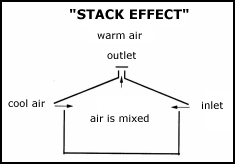
2. Aspiration
 |
air is moved by the action of the wind blowing
across the roof of the barn |
 |
this action draws air out through any
available opening |
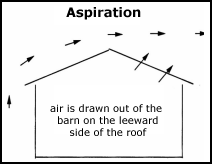
3. Perflatation
 |
wind is blown through openings in the
barn |
 |
air is moved from side to side or from end to
end |
Ways to achieve a well ventilated barn
 |
in warmer weather, windows and doors are
usually open |
 |
permanent openings should be installed to
achieve sufficient air changes when windows and doors are closed |
 |
the greater the height difference between
inlets and outlets the greater the ventilation rate |
Inlets
 |
installed along each long side of your
barn |
 |
hinged on the inside bottom side of the vent
(will help avoid drafts) |
 |
baffled vents will help prevent drafts and the
entry of snow or rain |
 |
place as low as possible but not at a height
that could interfere with your horse |
 |
should be adjustable |
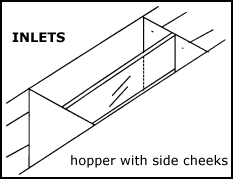
Outlets
 |
continuous ridge along the peak of your roof
or chimney(s) |
 |
should be capped to prevent water from
entering |
 |
a copula on the chimney will prevent water
from entering |
 |
if the barn has a loft make sure that there
are openings in the floor of the loft to allow air to reach the outlets at roof
level |
 |
or extend an insulated chimney down through
the loft to the stable ceiling |
 |
rule of thumb - install inlets twice the area
as outlets |
 |
if using a mechanical system, install an
extractor fan in the base of the chimney |
 |
the recommended pitch in the roof is 1:2 with
a roof overhang of 2-3 ft |
Insulation
Important for all seasons
Winter
conserves heat and reduces condensation
Summer
prevents heat of sun from heating barn
Spring and Fall
minimises temperature fluctuations caused by warm days and cold nights
Ventilation and insulation work together
 |
during the winter ventilation is usually
greatly reduced to keep the barn warm |
 |
if the reduced ventilation does not remove the
moisture produced by the horses the result will be a cold, clammy, damp barn
with condensation problems |
 |
if the barn is insulated and not properly
ventilated it will be even worse |
 |
condensation occurs when warm stable air hits
a cold inside wall |
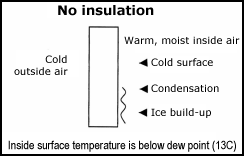
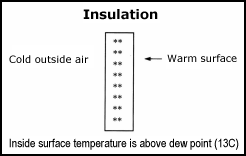
Installation
 |
the vents in an insulated barn can be smaller
than in a non-insulated barn |
 |
a vapour barrier on the inside wall will help
prevent condensation within the insulation |
 |
the more porous an insulating material is, the
greater is its insulating power |
 |
if you are limited in what you can do,
insulate the roof first |
Heat
(usually not necessary)
 |
could prove useful if your barn is still cold
and damp in the winter |
 |
it is better to add supplemental heat than
reduce ventilation |
 |
a number of infrared heaters are suitable for
barns |
The
Checklist
| |
Your
Dimension |
Recommendation |
| Stall Size |
|
12 × 12ft (3.6 ×
3.6m) |
| Stall Door Width |
|
4 ft (1.2m) |
| Stall Door Height |
|
8ft (2.4m) |
| Stall Ceiling
Height |
|
12ft (3.66m) |
| Floor Area Per
Horse |
|
150ft2
(14m2) |
| Airspace Per Horse |
|
1553ft3
(44m3) |
| Outlet Area Per
Horse* |
|
1.08ft2
(0.1m2)** |
| Inlet Area Per
Horse |
|
3.23ft2
(0.3m2) |
| Humidity Range |
|
30% - 70% |
| Temperature Range |
|
0 - 30°C (32 -
85°F) |
*note: an insulated stable can have slightly smaller inlets and outlets
**note: may only be suitable for smaller buildings - may be more appropriate
for medium and larger buildings: general rule of thumb: 1 to 1.5% of floor area
= area required for an open ridge ventilator.
How to measure your barn
Floor area per
horse:
length of barn
× width of barn
# of horses Airspace per horse:
If the barn has a closed loft:
length of barn × width of barn × height of
barn
# of horses
If the barn has an open pitched
roof:
|
a. volume of barn without
roof: |
|
length of barn × width of barn × height of
barn |
|
|
|
b. volume of pitched
roof: |
|
barn length × barn width × height of highest roof
point
2 |
|
|
|
c. volume of
barn: |
|
answer a + answer b |
|
|
|
d. airspace per
horse: |
|
answer c
# of horses |
Outlet area per
horse:
total area of
all chimneys or all outlet vents
# of horses
Inlet area per
horse:
total area of
all inlet vents or open windows
# of horses

